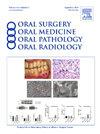Dentoalveolar manifestations as the presenting sign of Gardner syndrome
IF 1.9
3区 医学
Q2 DENTISTRY, ORAL SURGERY & MEDICINE
Oral Surgery Oral Medicine Oral Pathology Oral Radiology
Pub Date : 2025-07-21
DOI:10.1016/j.oooo.2025.04.009
引用次数: 0
Abstract
Background
Gardner syndrome (GS) is a rare variant of familial adenomatous polyposis (FAP) associated with highly penetrant mutations involving the adenomatous polyposis coli (APC) tumor suppressor gene. Although GS is typically inherited as an autosomal dominant trait, approximately 30% of cases may represent de novo mutations. GS is classically characterized by multiple premalignant gastrointestinal polyps, osteomas, epidermoid cysts, and both cutaneous and subcutaneous soft tissue tumors. However, in correlation with the specific position of the mutations within the APC gene, GS demonstrates variable clinical expressivity. Between 22% and 30% of patients with GS present with dental abnormalities consisting of multiple impacted teeth, supernumerary teeth, and odontomas. These dental abnormalities may precede the intestinal manifestations and may serve as a key feature in early diagnosis of this syndrome.
Case Summary
A 14-year-old, otherwise healthy and asymptomatic, female patient presented to the orthodontic clinic with complaint of over-retained primary teeth. Clinical and radiographic evaluation revealed multiple impacted permanent teeth, micro-odontomas, and areas of sclerotic dense bone without significant facial deformity. On further inquiry, no familial pattern is identified within the patient’s immediate family. Subsequent medical and imaging workup led to identification of multiple adenomatous and tubular gastrointestinal polyps and a paraspinal desmoid fibromatosis. Further genetic studies confirmed a diagnosis of GS.
Conclusion
This case highlights the significance of recognition of the dentoalveolar manifestations in the early diagnosis of GS emphasizing on the importance of interdisciplinary collaboration and maintaining open communication with other healthcare practitioners. Dental clinicians may serve a key role in the early diagnosis and instigation of adequate treatment of this life-threatening rare syndrome.
牙槽表现是加德纳综合征的表现
背景:gardner综合征(GS)是一种罕见的家族性腺瘤性息肉病(FAP)变体,与大肠腺瘤性息肉病(APC)抑癌基因的高渗透性突变有关。虽然GS通常遗传为常染色体显性性状,但大约30%的病例可能表现为新生突变。GS的典型特征是多发性胃肠道息肉、骨瘤、表皮样囊肿以及皮肤和皮下软组织肿瘤。然而,与APC基因中突变的特定位置相关,GS表现出可变的临床表达性。22%至30%的GS患者存在牙齿异常,包括多颗阻生牙、多生牙和牙瘤。这些牙齿异常可能先于肠道表现,并可作为该综合征早期诊断的关键特征。病例总结:一名14岁的女性患者,其他方面健康无症状,以乳牙过度保留到正畸诊所就诊。临床及影像学检查显示有多颗阻生恒牙、微型牙瘤及骨硬化致密区,无明显面部畸形。经进一步调查,在患者的直系亲属中未发现家族型。随后的医学和影像学检查确定了多发性腺瘤性和管状胃肠道息肉和脊柱旁硬纤维瘤病。进一步的基因研究证实了GS的诊断。结论本病例强调了牙槽牙表现在GS早期诊断中的重要性,强调了跨学科合作和与其他医护人员保持开放沟通的重要性。牙科临床医生可能在早期诊断和鼓动适当治疗这种危及生命的罕见综合征方面发挥关键作用。
本文章由计算机程序翻译,如有差异,请以英文原文为准。
求助全文
约1分钟内获得全文
求助全文
来源期刊

Oral Surgery Oral Medicine Oral Pathology Oral Radiology
DENTISTRY, ORAL SURGERY & MEDICINE-
CiteScore
3.80
自引率
6.90%
发文量
1217
审稿时长
2-4 weeks
期刊介绍:
Oral Surgery, Oral Medicine, Oral Pathology and Oral Radiology is required reading for anyone in the fields of oral surgery, oral medicine, oral pathology, oral radiology or advanced general practice dentistry. It is the only major dental journal that provides a practical and complete overview of the medical and surgical techniques of dental practice in four areas. Topics covered include such current issues as dental implants, treatment of HIV-infected patients, and evaluation and treatment of TMJ disorders. The official publication for nine societies, the Journal is recommended for initial purchase in the Brandon Hill study, Selected List of Books and Journals for the Small Medical Library.
 求助内容:
求助内容: 应助结果提醒方式:
应助结果提醒方式:


